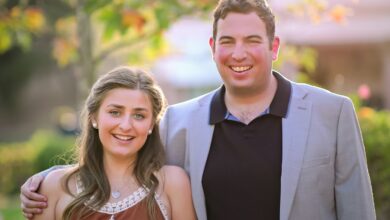How Queen Elizabeth’s Bees Inspired My New Novel (Exclusive)
:max_bytes(150000):strip_icc():format(jpeg)/John-Chapple-bees-090525-2-c49c7476d9b04dbebb59521f1be493ee.jpg)
When Queen Elizabeth II died on Sept. 8, 2022, the whole world learned of her passing. Television, radio and newspapers spread the word, but it was up to one man, John Chapple, to inform tens of thousands of her tiniest subjects — her bees.
Chapple, the late Queen’s beekeeper, went first to Clarence House and then Buckingham Palace to perform his somber duty of telling the bees, a centuries-old custom of informing the bees when their owner has died. Rooted in Celtic tradition, this practice ensures that the bees will remain with their hives and continue to produce honey. According to folklore, failure to notify the bees invites disaster. They will stop making honey, abandon their homes or even die themselves. Chapple tied black ribbons around the hives to allow the bees to mourn properly, then knocked on the roof of each hive and announced the death of the queen, assuring the bees that they would continue to be cared for.
Some beekeepers expand this tradition to include sharing any major news in the family, such as a birth or marriage. Humans feel more connected to their family when they are up-to-date on their loved ones, so why not bees? Humans have long recognized that their fate is tied to the well-being of bees, and it is understandable that keeping them healthy and happy is of utmost importance.
I first learned of the tradition of telling the bees when I read a newspaper clipping dated June 4, 1956 from the Danville Bee about thousands of bees that attended the funeral of John Zepka, their keeper. It is said the bees gathered at the cemetery, resting on the tent over the grave and on the floral displays, returning to their hives after the service concluded. I became fascinated by the idea of the bees’ sentience and empathy and began researching this curious event.
Getty
Talking to bees is a well-established custom, I learned. But what if the bees talked back? An idea for the book that became my new novel Bees in June formed in my head about a young woman named Rennie who has suffered the tragic loss of her infant son and is enduring an increasingly abusive marriage. She receives help from an unlikely source, the bees once owned by her late Aunt Eugenia. Hailing from the foothills of Appalachia, Eugenia was called a witch by some, while others considered her a healer. Eugenia’s bees are magic, and can communicate with those they love.
My imagination took me further into the story. What if the bees had their own point of view? They could serve as an omniscient Greek chorus to comment, judge and even interfere. I’ve written stories since I learned to print, but I had mostly dealt with humans, along with a few dogs and cats. How could I write from a bee’s perspective?
It might be time to admit that I am an Anglophile as I explain how I struggled to find the bees’ voice. The roots of my family tree are firmly established in the soil of Great Britain. I start every day with a strong cup of English breakfast tea and spent my Junior year of college at the University of Kent in Canterbury. I majored in English literature, and consider the day I was alone with Princess Diana’s wedding dress in a small Welsh museum a highlight of my life. As I pondered bees as characters, I realized I wanted them to be British, honoring the Celtic tradition that started this journey.
Once that decision was made, their voice came easily, and I wrote their chapters with a British accent in my head as I typed. The bees quickly became my favorite part of the story. They were omniscient, untethered to any human timeline, and had a penchant for archaic words like sluberdegullion, used to describe Rennie’s no-good husband. They were noble and brave, but also not above meddling when the humans strayed from their paths, as humans tend to do.
When it was time to cast the bees’ voices for the audiobook, I was initially horrified when I was told HarperCollins wanted men voicing my beloved bees: “You want drones to read their parts?” Bees are matriarchal, with a queen bee in charge of the hive. The males, or drones, serve only one purpose, to mate with the queen. Were drones really up to the job of narrating the all-important bee chapters?
Never miss a story — sign up for PEOPLE’s free daily newsletter to stay up-to-date on the best of what PEOPLE has to offer , from celebrity news to compelling human interest stories.
The powers that be explained to me that in the audiobook, there would be no easy way to identify the bees’ chapters, which were designated with italics in the printed version, unless the narrator’s voice changed from female to male. “Can they be British?” I asked. Not everyone would understand the Celtic nod, I was told, so American drones it was. But I was allowed to select the two male narrators, who did a splendid job. Now I can’t imagine the bees being brought to life any other way.
Harper Muse
The phrase busy as a bee certainly applies to bees in June. Their work begins in earnest as they literally bring forth the abundance of summer, pollinating plants and flowers. A 17th-century poem, which reads in part, a swarm of bees in June is like a silver spoon, provided my title. The main character, Rennie, was born in June, and her aunt and uncle were married in June. The article about Mr. Zepka’s bees attending his funeral was published in June. And Queen Elizabeth, a queen bee like none other, celebrated her official birthday in June. So as we commemorate her passing, let’s celebrate the wonder and magic of bees.
As Uncle Dixon says to Rennie, “Bees are some of God’s best work, and a bee in June is the best of all. Watch a bee and she’ll show you what’s right and how we should go. Treasure every bee you see.”
Bees in June by Elizabeth Bass Parman is available now, wherever books are sold.
Credit to Nypost AND Peoples



